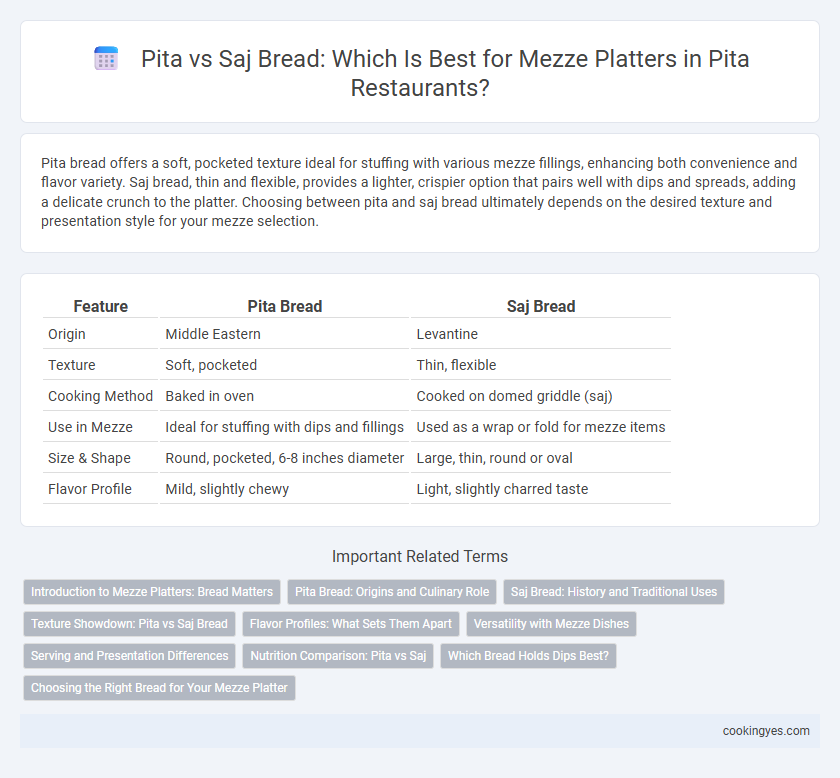Pita bread offers a soft, pocketed texture ideal for stuffing with various mezze fillings, enhancing both convenience and flavor variety. Saj bread, thin and flexible, provides a lighter, crispier option that pairs well with dips and spreads, adding a delicate crunch to the platter. Choosing between pita and saj bread ultimately depends on the desired texture and presentation style for your mezze selection.
Table of Comparison
| Feature | Pita Bread | Saj Bread |
|---|---|---|
| Origin | Middle Eastern | Levantine |
| Texture | Soft, pocketed | Thin, flexible |
| Cooking Method | Baked in oven | Cooked on domed griddle (saj) |
| Use in Mezze | Ideal for stuffing with dips and fillings | Used as a wrap or fold for mezze items |
| Size & Shape | Round, pocketed, 6-8 inches diameter | Large, thin, round or oval |
| Flavor Profile | Mild, slightly chewy | Light, slightly charred taste |
Introduction to Mezze Platters: Bread Matters
Pita bread offers a soft, pocketed texture ideal for stuffing with dips and fillings on mezze platters, enhancing variety and presentation. Saj bread, thinner and crispier, provides a delicate crunch that contrasts well with creamy spreads, making it perfect for layering flavors. Selecting the right bread type significantly impacts the balance and enjoyment of mezze assortments.
Pita Bread: Origins and Culinary Role
Pita bread, originating from the Middle Eastern and Mediterranean regions, is a key staple for mezze platters, known for its distinctive pocket that holds dips like hummus and baba ganoush. Its soft, slightly chewy texture and ability to be easily torn or filled make it ideal for pairing with assorted spreads and salads in mezze presentations. The traditional baking method involving high heat creates the iconic puffed pocket, enhancing its culinary versatility compared to other flatbreads like saj.
Saj Bread: History and Traditional Uses
Saj bread, a thin, round flatbread cooked on a convex metal griddle called a saj, has ancient origins traced back to Middle Eastern and Levantine cuisine. Traditionally, it is used for wrapping a variety of fillings such as grilled meats, herbs, and vegetables, making it ideal for mezze platters that emphasize fresh, flavorful components. Its unique texture and flexibility differentiate it from pita bread, offering a lighter, crispier base that complements an array of regional dips and spreads.
Texture Showdown: Pita vs Saj Bread
Pita bread features a soft, pillowy texture with a slightly chewy bite, perfect for scooping dips and holding fillings without tearing. Saj bread offers a thinner, crispier texture with a subtle crunch that complements lighter spreads and delicate mezze components. The choice between pita and saj bread for mezze platters hinges on whether a tender, robust bread or a crisp, flaky bread best suits the variety of flavors and textures presented.
Flavor Profiles: What Sets Them Apart
Pita bread features a mildly tangy flavor with a chewy texture that complements creamy dips and robust spreads on mezze platters, while Saj bread offers a lightly toasted, slightly smoky taste with a thin, crispy texture ideal for wrapping or scooping. The distinct flavor profiles stem from their different baking techniques: pita is oven-baked, creating its signature pocket, whereas saj bread is cooked on a dome-shaped griddle, lending it subtle charred notes. These differences enhance the overall mezze experience by providing contrasting textures and tastes that pair uniquely with Mediterranean appetizers.
Versatility with Mezze Dishes
Pita bread offers unmatched versatility for mezze platters, easily folding or tearing to hold a variety of dips like hummus, baba ganoush, and tzatziki. Its pocket-style structure allows for convenient stuffing, enhancing the presentation and portion control of mezze dishes. Saj bread, while thinner and slightly crispier, excels as a wrap but lacks the hollow compartment that makes pita ideal for filled mezze options.
Serving and Presentation Differences
Pita bread features a pocket structure ideal for stuffing with mezze ingredients, creating handheld, portable servings that emphasize convenience and layering. Saj bread offers a larger, thinner, and flexible base perfect for wrapping or folding around mezze components, enhancing presentation through open-faced or rolled displays. The choice between pita and saj influences the mezze platter's visual appeal and ease of serving, with pita promoting compact portions and saj allowing more expansive, shareable arrangements.
Nutrition Comparison: Pita vs Saj
Pita bread typically contains about 165 calories per 60-gram serving with 33 grams of carbohydrates, 6 grams of protein, and 1 gram of fat, making it a balanced option for mezze platters. Saj bread, often thinner and made with similar ingredients, generally has fewer calories, around 130 per serving, and slightly lower carbohydrates but comparable protein content. Both breads offer low sugar and moderate fiber levels, but pita provides a denser texture and higher caloric content, ideal for heartier dips and fillings.
Which Bread Holds Dips Best?
Pita bread features a thicker, pocket-like structure that efficiently holds dips and chunky spreads without tearing, making it ideal for mezze platters with hummus or baba ganoush. Saj bread, thinner and more flexible, tends to be less sturdy, causing it to absorb moisture quickly and become soggy when paired with watery dips. For mezze platters prioritizing dip retention and ease of scooping, pita bread offers superior durability and functionality.
Choosing the Right Bread for Your Mezze Platter
Pita bread offers a soft, pocketed texture ideal for holding dips and fillings, making it a popular choice for mezze platters that emphasize individual servings. Saj bread, thin and slightly crisp, provides a delicate, flexible base that complements lighter spreads and fresh vegetables without overpowering flavors. Selecting between pita and saj should consider the desired texture balance and the types of mezze included, ensuring an optimal pairing that enhances both presentation and taste.
Pita vs Saj Bread for mezze platters Infographic

 cookingyes.com
cookingyes.com